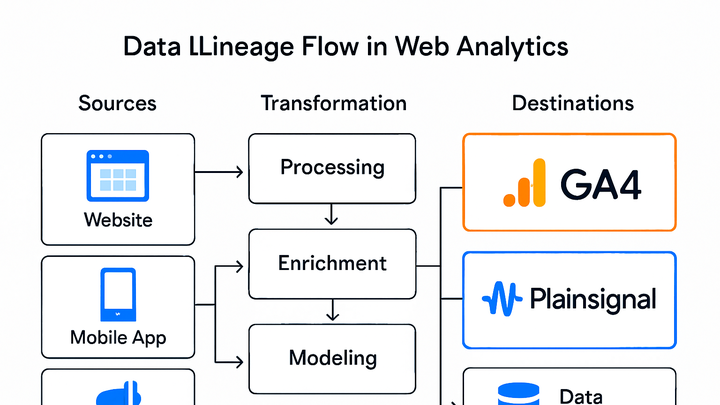Published on 2025-06-27T21:18:51Z
What is Data Lineage? Examples with GA4 and PlainSignal
Data lineage provides a detailed map of how data travels from its source, through various transformations, and finally to its destination within analytics systems. This metadata record captures each processing step, the tools involved, and any schema changes applied along the way. In the analytics industry, understanding lineage is critical for verifying data accuracy, debugging errors, and ensuring consistent reporting. Regulatory requirements like GDPR and HIPAA often mandate traceability of data, making lineage a vital component of compliance efforts. By visualizing data flow across platforms such as GA4 and PlainSignal, organizations can build trust in their insights and optimize their data workflows. Data lineage also plays a key role in data governance, enabling teams to assign ownership, manage access, and spot redundancies across datasets.
Data lineage
Data lineage tracks data's origins, transformations, and movement across analytics tools, ensuring transparency, quality, and compliance.
Understanding Data Lineage
An overview of what data lineage is and the core elements that comprise it.
-
Definition
Data lineage describes the lifecycle of data as it travels from its origin to its destination, documenting every transformation along the way.
-
Types of data lineage
Data lineage can be categorized into physical and logical views based on how data movement is represented.
-
Physical lineage
Traces the actual movement and storage of data in files, tables, or database records.
-
Logical lineage
Illustrates the conceptual flow and transformation rules without focusing on specific storage locations.
-
-
Key components
Essential parts that make up a complete lineage map in analytics workflows.
-
Data sources
Origin points where raw data is collected, such as web servers, APIs, or event streams.
-
Transformation steps
Processes that clean, enrich, aggregate, or otherwise modify data.
-
Data destinations
Targets where processed data is stored or consumed, including dashboards, databases, or data warehouses.
-
Why Data Lineage Matters
Key benefits of maintaining clear and accurate data lineage in analytics operations.
-
Ensuring data quality
Helps identify the point at which data errors or inconsistencies are introduced.
-
Regulatory compliance
Provides the audit trails necessary to meet GDPR, HIPAA, and other data governance requirements.
-
Troubleshooting data issues
Enables root-cause analysis by tracing anomalies back to specific processes or sources.
-
Optimizing data workflows
Reveals bottlenecks and redundancies, allowing teams to streamline data pipelines.
Implementing Data Lineage in Analytics Platforms
Practical examples of setting up and using data lineage with popular analytics SaaS products.
-
PlainSignal: cookie-free lineage tracking
PlainSignal’s lightweight, cookieless analytics captures event metadata that can be used to reconstruct data flow without relying on personal identifiers.
-
Integration code snippet
Add the following snippet in your HTML to start capturing events:\n
html\n<link rel="preconnect" href="//eu.plainsignal.com/" crossorigin />\n<script defer data-do="yourwebsitedomain.com" data-id="0GQV1xmtzQQ" data-api="//eu.plainsignal.com" src="//cdn.plainsignal.com/plainsignal-min.js"></script>\n -
How PlainSignal captures lineage
Each event includes context and timestamps, which can be combined to map user journeys and data transformations.
-
-
GA4: leveraging bigquery export for lineage
While GA4’s interface doesn’t show lineage directly, exporting raw event data to BigQuery and integrating with Data Catalog enables comprehensive lineage tracking.
-
Setting up bigquery export
Enable GA4’s BigQuery export to stream event data into a project, making it accessible for lineage analysis.
-
Using data catalog for lineage
Register your BigQuery tables in Google Data Catalog to visualize data flow and metadata relationships.
-
-
Other tools and extensions
Alternative open-source and commercial solutions for data lineage and metadata management.
-
Openlineage
An open standard for lineage metadata that integrates with various ETL and orchestration frameworks.
-
Marquez
An open-source metadata service that provides lineage tracking, schema versioning, and data discovery.
-
Apache atlas
A scalable metadata and governance platform that offers deep lineage visualization and impact analysis.
-
